Intel Unveils Moorestown and the Atom Z600, The Fastest Smartphone Platform?
by Anand Lal Shimpi on May 4, 2010 11:54 PM EST- Posted in
- Smartphones
- Intel
- Atom
- Mobile
- SoCs
CPU Performance: Moorestown Rocks?
In my iPad review I pointed out the huge gap between the performance of today’s 1GHz smartphone SoCs and an Atom powered netbook.
It’s impossible to estimate the performance of Moorestown without functional hardware, but we can assume that it’s somewhere in between the ARM based SoCs and the netbook in the chart below.
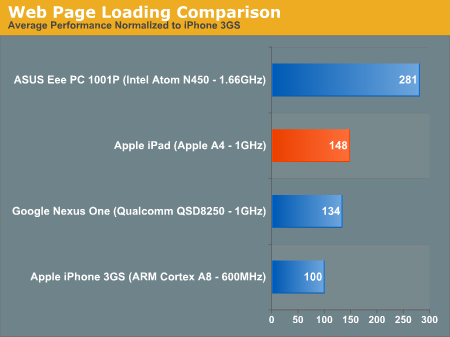
Intel provided some SPECint numbers comparing Moorestown to various smartphone application processors shipping in 2010 (either now or later). Keep in mind that SPECint is just as much of a compiler benchmark as it is a hardware benchmark, so real world performance could very well differ. We won’t know how well Moorestown stacks up until we can evaluate it ourselves. But if Intel’s numbers are even remotely accurate, this is the sort of leap in performance we honestly need in the smartphone space:
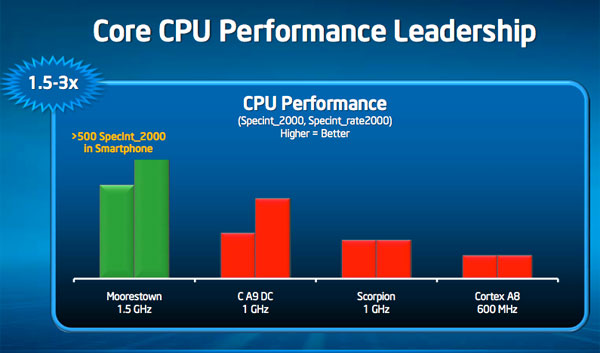
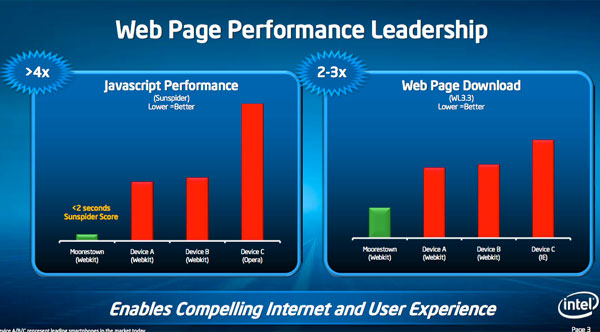
The slowest member of the Atom Z600 series will run at 1.2GHz, the fastest (for smartphones) will run at 1.5GHz. While multithreaded performance on a dual Cortex A9 at 1GHz approaches that of a 1.2GHz Moorestown, nothing can touch the 1.5GHz part. Single threaded performance is just as impressive.
The Sunspider score is super impressive as well. Intel is posting a sub-2s Sunspider score, the best we've seen thus far on a ARM based platform is ~10 seconds on the iPad:
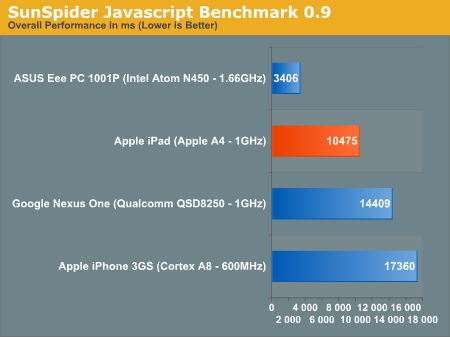
These numbers are from Intel so we have to take them with a grain of salt. And as I already mentioned, we’re looking at pure CPU/compiler performance here - real world application performance is a different story entirely. But it’s a safe bet to assume that Moorestown will at least be faster than any application processor on the market today.
A high clocked dual Cortex A9 could give it a healthy challenge though.
GPU Performance: Moorestown Rules?
Intel provided three numbers to instill confidence in Moorestown’s graphics capabilities. The first was a claim of over 100 fps running Quake 3. I saw this in person so I can confirm that you can actually run a timedemo of Quake 3 at above 100 fps on Moorestown. NVIDIA claims over 40 fps on the Tegra 2 at 720p with AA, but it’s unclear how comparable these numbers are.
The next two numbers are from 3DMark Mobile ES 2.0 using the Taiji and Hoverjet benchmarks:
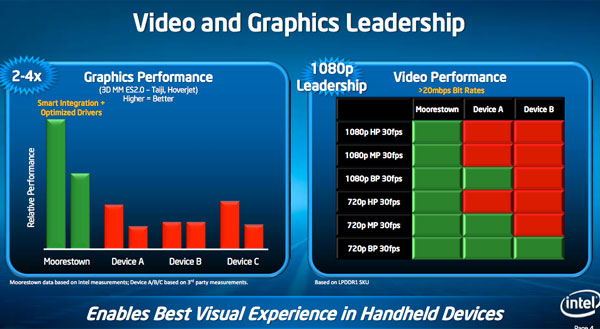
This is comparing the performance of Moorestown to the lower clocked SGX 535 among other GPUs. The performance improvement is more than 2x.
Again, these came from Intel directly so we can’t vouch for their applicability to the real world.










67 Comments
View All Comments
teohhanhui - Thursday, May 6, 2010 - link
But they'll be showcasing it on their Moblin/Meego which is Linux. Won't shoot themselves in the feet, will they?rahvin - Thursday, May 6, 2010 - link
And if it only runs on Moblin, only with specific kernel versions, uses a binary blob driver and isn't maintained it will be the same story as GMA500 all over again.strikeback03 - Thursday, May 6, 2010 - link
As pointed out, plenty of other Android phones are using the same graphics. And I haven't heard a lot of complaints about lack of drivers for the Droid/N1/etc.elisha.pan - Wednesday, May 5, 2010 - link
GMA500 has nothing with the Intel GMA series, but name. It is exactly the same with PowerVR SGX 535.DanNeely - Wednesday, May 5, 2010 - link
This is the same GPU used in almost every other smart phone on the market, except that it's designed to be clocked up to twice as fast. It's not going to run Crysis *rolls eyes* but it's more than capable of doing everything a smart phone/internet tablet will need to do.ekul - Wednesday, May 5, 2010 - link
exactly. without open source drivers for the graphic any development of meego outside of intel will never go anywhere. One of the reasons I bought my current netbook is the gma 950 has excellent open source drivers that just work.Open source development moves fast. Closed source binaries get left behind because they can't keep up with the release schedule. The current gma 500 drivers already need a kernel several versions old as well as an old X server. How many releases is meego going to miss?
ViRGE - Wednesday, May 5, 2010 - link
I can see why Anand thinks it's an interesting product, but based on his article I don't think Intel is quite there.The current need for 5 chips is going to be a problem no matter how Intel dresses things up, and if all phones end up looking like the design shown I wouldn't be surprised if the consumer reaction was tepid - a phone of that size is still pretty big. The video playback time is also going to be a problem when it comes to spec sheets (I doubt the real-world impact will be as huge), but OEMs like their spec sheets and consumers aren't too far off either. Just looking like it'll perform poorly there may be enough.
The other issue is the reliance on an OS. At this point it seems like no one really wants another OS. Most people around here seemed to be more relieved than concerned when Palm went under. With BlackBerryOS, IPhoneOS, Android, and WinCE, there seems to be as many OSes as the market can reasonably handle. Moblin/MeeGo may be necessary for the hardware right now, but I see no reason to expect that it's going to be properly developed for consumer use like the above OSes were. Unless Intel can land RIM/Apple, they need to get Android up to par on Moorestown and they need to do it yesterday.
Ultimately I think it's going to Medfield that's a proper ARM competitor. With fewer chips it will fit in to traditional designs, and with any luck Intel will be a node ahead of its competition on the manufacturing process. It won't solve the current OS reliance, but it'll put them in a better position than Moorestown does.
ET - Wednesday, May 5, 2010 - link
Ultimately I think that most people don't care about the OS. The OS mainly matters in terms of applications available for it, and it's a pain for developers to address many OS's, but also an opportunity for new developers to carve their niche.That said, Anand did mention that Intel is making Android available for this new platform, which should be good enough.
IntelUser2000 - Wednesday, May 5, 2010 - link
It's much closer than expected. There were quite frequent comments that thought it wouldn't even reach 5 hour on standby! Having a lot of knowledge and doing a bit research helps of course. Glad they can be roughly on par though.It's likely the idle power can't be achieved without optimized OSes. Even if you can run Windows on it, what's the point when you won't have the battery life for it? Windows uses too much on keeping legacy support and its too bloated for idle power under 50mW.
Platform approach is the key to low power on Moorestown.
piroroadkill - Wednesday, May 5, 2010 - link
I'm not sold. ARM has been more efficient for a lot longer, even though it's still being made on commonly larger processes than current Intel CPUs. All smartphones are ARM anyhow, so I don't see the advantage in having x86 in this space